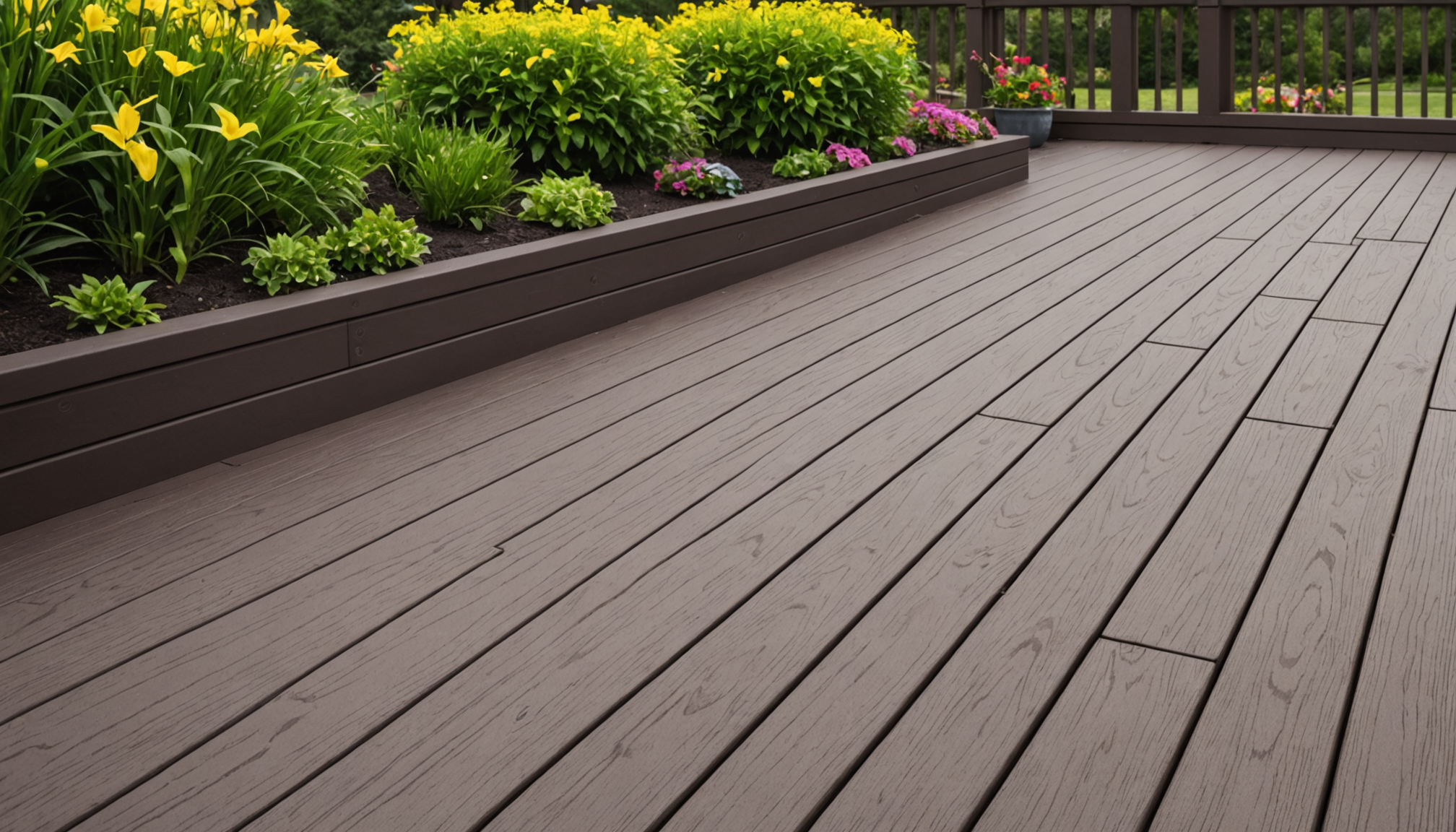One of the most crucial steps in ensuring the longevity of your deck is selecting the right materials. The choices you make in this early stage can significantly influence not only the durability and maintenance requirements of your deck but also its appearance and performance in different environmental conditions. By understanding the different materials available, you can make informed decisions that align with your vision and practical needs.
When considering materials, your primary choices are typically between natural wood and composite materials. Each option comes with its distinct set of advantages and potential drawbacks. Here, we provide a comprehensive overview of the main types of decking materials to help guide your decision-making process:
| Material Type | Durability | Maintenance | Cost | Aesthetic |
| Pressure-Treated Wood | High – Resistant to rot and insects | High – Requires regular sealing or staining | Low to Moderate | Traditional wood appearance |
| Cedar or Redwood | Moderate – Natural resistance to decay and insects | Moderate – Needs regular cleaning and sealing | Moderate | Natural beauty and warmth |
| Composite Decking | Very High – Resists fading, staining, scratching, and mold | Low – Requires occasional cleaning | High | Variety of styles and colors, less natural look |
| Hardwood (e.g., Ipe, Teak) | Very High – Extremely durable | Moderate – Benefits from regular oiling | High | Luxurious and exotic appearance |
Pressure-treated wood is often chosen for its affordability and strength. Its treatment involves chemicals that make it resistant to fungal growth and insect infestations, though it can be prone to splitting, and warping over time if not properly maintained. Regular sealing is essential to prolong its lifespan.
Cedar and redwood are valued for their beautiful, natural appearance and inherent resistance to decay and insects. They are softer woods, so they’re more susceptible to dents and scratches, but with proper care, including sealing to prevent moisture absorption, they can remain attractive for years.
Composite decking materials offer an impressive combination of low maintenance with high durability. Made from a mix of plastic and wood fibers, these boards are designed to withstand the elements and retain their color without the need for staining. Though the upfront cost is higher, many see the reduced maintenance as a significant long-term benefit.
Hardwoods like Ipe and Teak are premium choices known for their exceptional density and resistance to wear and tear. They require less frequent oiling to maintain their appearance, but their strength and beauty often justify the investment for those seeking a luxurious deck.
Selecting the right materials involves balancing these factors in the context of your budget, desired appearance, and willingness to commit to future maintenance. By anticipating the challenges specific to your environment—such as high humidity, intense sun, or harsh winters—you can choose materials that will stand the test of time, thereby maximizing the return on your investment.
effective cleaning techniques
Maintaining the cleanliness of your deck is essential to ensuring its longevity. Effective cleaning techniques not only preserve appearance but also help prevent mold, mildew, and rot. Here’s a step-by-step guide to keep your deck looking its best with minimal effort:
1. Choose the Right Cleaning Solution:
Begin by selecting an appropriate cleaning solution suited for your decking material. Natural woods like cedar and redwood can benefit from gentle cleaners, while composite materials often require a formulation designed to tackle mildew and stains without causing damage.
2. Pre-Treat Stains or Mold:
Identify any problem areas on your deck, such as grease spots or mold patches. Apply a concentrated cleaner to these spots first, allowing it to sit for about 10-15 minutes. This pre-treatment will help break down tougher stains, making them easier to remove during the full clean.
3. Sweep the Deck:
Clear the deck of any debris such as leaves, dirt, or branches. Use a stiff-bristle broom to sweep away loose contaminants, ensuring a clean surface that allows the cleaning solution to penetrate more effectively.
4. Apply the Cleaner:
Using a garden hose or a deck sprayer, wet the entire deck to prepare it for cleaning. Afterward, apply the cleaning solution uniformly across the surface. A long-handled brush is beneficial for ensuring even coverage, particularly in grooved or textured areas.
5. Scrub with Effort:
Gently scrub the deck with a soft-bristle brush, targeting wood grains and any accumulated grime. Avoid harsh scrubbing, especially on softer woods, to prevent scratches or dents.
6. Rinse Thoroughly:
After scrubbing, thoroughly rinse the deck with a hose to remove all traces of the cleaning solution. It is crucial to ensure that no soap residue is left, as this can attract dirt or cause unwanted bleaching in the sun.
7. Inspect and Repeat if Necessary:
Once the deck is dry, inspect for areas that may need another round of cleaning, particularly if it’s been neglected for an extended period or suffered from excessive dirt buildup.
8. Use a Pressure Washer (Optional):
For severe stains or large decks, a pressure washer can be used. Set the machine to a low-pressure setting to avoid damaging the deck. Maintain a consistent distance from the surface and use a sweeping motion to clean evenly.
9. Apply a Protective Coating:
After cleaning and once the deck is completely dry, consider applying a protective finish, stain, or sealant to add an extra layer of protection against future dirt and damage. This step varies depending on the material and desired maintenance schedule.
By integrating these cleaning techniques into your regular maintenance routine, you can significantly prolong the lifespan of your deck. Not only does this ensure lasting beauty, but it also allows you to enjoy your outdoor space year after year without major renovations.
protecting against weather damage
Shielding your deck from the detrimental effects of various weather conditions is crucial in extending its lifespan. The elements can be particularly harsh on outdoor structures, causing them to degrade over time if not adequately protected. Implementing a few key strategies can drastically reduce wear and tear and preserve the integrity of your deck.
Begin by investing in high-quality sealants or stains. Natural woods, in particular, benefit from stains that penetrate deep into the wood fibers, offering protection from moisture intrusion and ultraviolet (UV) rays. These products should be applied every couple of years, or as recommended by the manufacturer. When applying, focus on the exposed areas that bear the brunt of the sun or are prone to water pooling, ensuring complete coverage for maximum efficacy.
For composite decks, while inherently more resistant to the elements, using specially formulated protectant sprays designed for the material can enhance their resistance to sun and water. These sprays create a film that shields the surface without altering its appearance, helping maintain the deck’s vibrancy and structural soundness.
A physical barrier is another consideration. Outdoor furniture covers, patio umbrellas, and even retractable awnings can provide additional protection from direct sunlight and rainfall. By minimizing exposure, these items can significantly reduce the risk of fading, warping, or cracking, especially for decks in continuous use during peak seasonal periods.
Adequate drainage is also critical. Ensure that your deck is slightly pitched away from your house, or has gaps between boards to facilitate water drainage. This simple step helps prevent water accumulation, which can lead to mold or mildew growth. Additionally, periodically clearing out debris from the spaces between boards and around the deck perimeter can further assist in maintaining effective water runoff.
Lastly, if your geographic location is prone to harsh winters, applying a water-repellent finish before the first frost can prevent moisture from seeping into the wood and freezing, which may cause expansion and cracking. Always use soft, plastic shovels to clear snow from your deck, as metal shovels could scratch or gouge the surface.
By proactively implementing these protective measures, you can mitigate weather-induced damage and maintain the deck’s structural and aesthetic integrity. This ensures that your outdoor space remains inviting and functional through every season, allowing for countless hours of enjoyment with minimal ongoing repairs.
repair and maintenance strategies
Regular maintenance strategies are fundamental in keeping your deck in pristine condition and enhancing its lifespan. Prioritizing prompt attention to repair needs is crucial, as even small issues can escalate into significant structural problems if left unaddressed.
One effective strategy is to regularly inspect your deck for any signs of damage, such as loose or broken boards, protruding nails, or soft spots that might indicate rot. These inspections should take place at least once per year, ideally in the spring, after harsh winter conditions have ceased. Timely identification of such issues allows for immediate repair, safeguarding your deck against further deterioration.
When addressing loose boards or nails, ensure each board is securely fastened to the joists with corrosion-resistant screws, as they provide greater durability and holding power compared to nails. If boards are cracked or severely damaged, it’s advisable to replace them entirely to prevent water from penetrating into the structural wood, which could exacerbate rot or decay.
For those areas affected by rot, a thorough removal and replacement process is necessary. Start by cutting out the rotten section carefully, extending the cut into the surrounding healthy wood to ensure all compromised material is removed. Fit a replacement piece of wood that is treated or naturally resistant to decay, and securely fasten it in place. Pay attention to maintaining the same width and thickness as the original board to sustain a uniform surface.
Another key strategy is to address minor damages proactively. Small holes or surface scratches can often be repaired using a wood filler designed for exterior use. These wood fillers should be water-resistant and capable of adhering strongly to the surfaces it is applied to. Once the filler has dried, sand the area smoothly to blend with the surrounding wood, ensuring an even surface that is ready for sealing or staining.
Joint reinforcements are also an effective preventative measure. Consider adding corner brackets or other forms of reinforcement at the connections between structural components. This additional support can help in mitigating any shear movements during heavy loads or adverse weather conditions, playing a pivotal role in maintaining overall deck stability.
Finally, a routine of reapplying protective coatings like sealant or stain is fundamental. These coatings not only enhance aesthetic appeal but serve as a vital barrier against moisture, insects, and UV damage. Schedule these applications according to your climate and the specific recommendations for the decking material you’ve chosen—typically every one to three years.
Incorporating these repair and maintenance practices into your regular deck care routine not only addresses existing issues but also fortifies your deck against future problems. By ensuring each element of the deck is in optimal condition and protected from environmental stressors, you enjoy its functionality and beauty for years, making the most of your outdoor space.
regular inspection and upkeep
To ensure your deck remains safe and appealing, establishing a routine for inspection and upkeep is essential. Begin by setting a schedule for periodic checks, ideally every three to six months, to identify and address any emerging issues promptly. During these inspections, look closely at the entire deck surface, joists, and hardware for wear and potential damage.
Start by examining the deck boards for signs of warping, splitting, or rot. Gently walk across the entire surface while applying pressure to detect any soft spots indicative of underlying decay. If you find loose or creaky boards, tighten or replace them immediately to maintain structural integrity. Regularly inspecting connecting points, including railings and stairs, is equally essential, as these areas are prone to loosening over time. Tighten screws or bolts as needed, and replace any rusted or corroded hardware to ensure the deck’s stability and safety.
Pay special attention to the fasteners and connectors, particularly if your deck is exposed to moist or coastal environments. Check for rust or corrosion and replace any compromised metal parts with stainless steel or other corrosion-resistant materials to prevent future damage. Additionally, inspect the deck’s underside where mold or mildew might develop due to trapped moisture and inadequate airflow. If detected, address the drainage or ventilation issues immediately to prevent the problem from escalating.
Cleaning is an integral part of upkeep, as accumulated dirt and organic debris can trap moisture and accelerate deterioration. Clear off leaves, dirt, and other debris regularly using a broom. If the climate allows, power washing once a year can help remove stubborn grime and reset the deck’s surface for seasonal finishing treatments.
After ensuring your deck is structurally sound, evaluate its need for protective treatments. Apply water-repellent sealers or stains every few years, depending on wear and the material used. These treatments shield your deck from UV damage, moisture intrusion, and other environmental stressors, helping to preserve its appearance and durability.
Lastly, it’s advantageous to document your inspection and maintenance processes. Maintain a log of performed tasks, repairs, and applied treatments, noting dates and products used. This record helps track the deck’s condition and assists in planning future maintenance activities, ultimately extending the life of your deck while ensuring it remains a safe and inviting space.
In conclusion, a long-lasting deck requires thoughtful planning in material selection, consistent cleaning, weather protection, efficient repair practices, and a regular inspection regimen. By thoughtfully engaging in these practices, you’re safeguarding your outdoor space as a durable, beautiful, and cherished part of your home for years of enjoyment.


